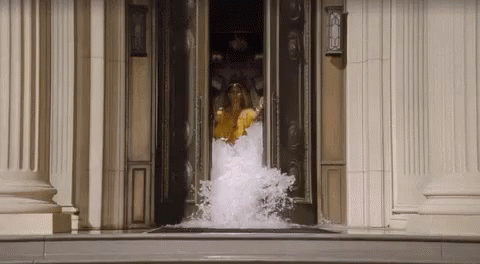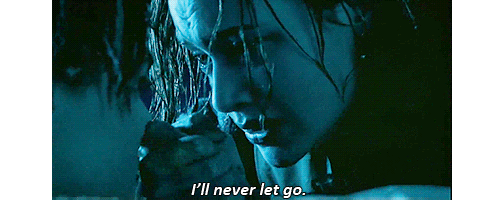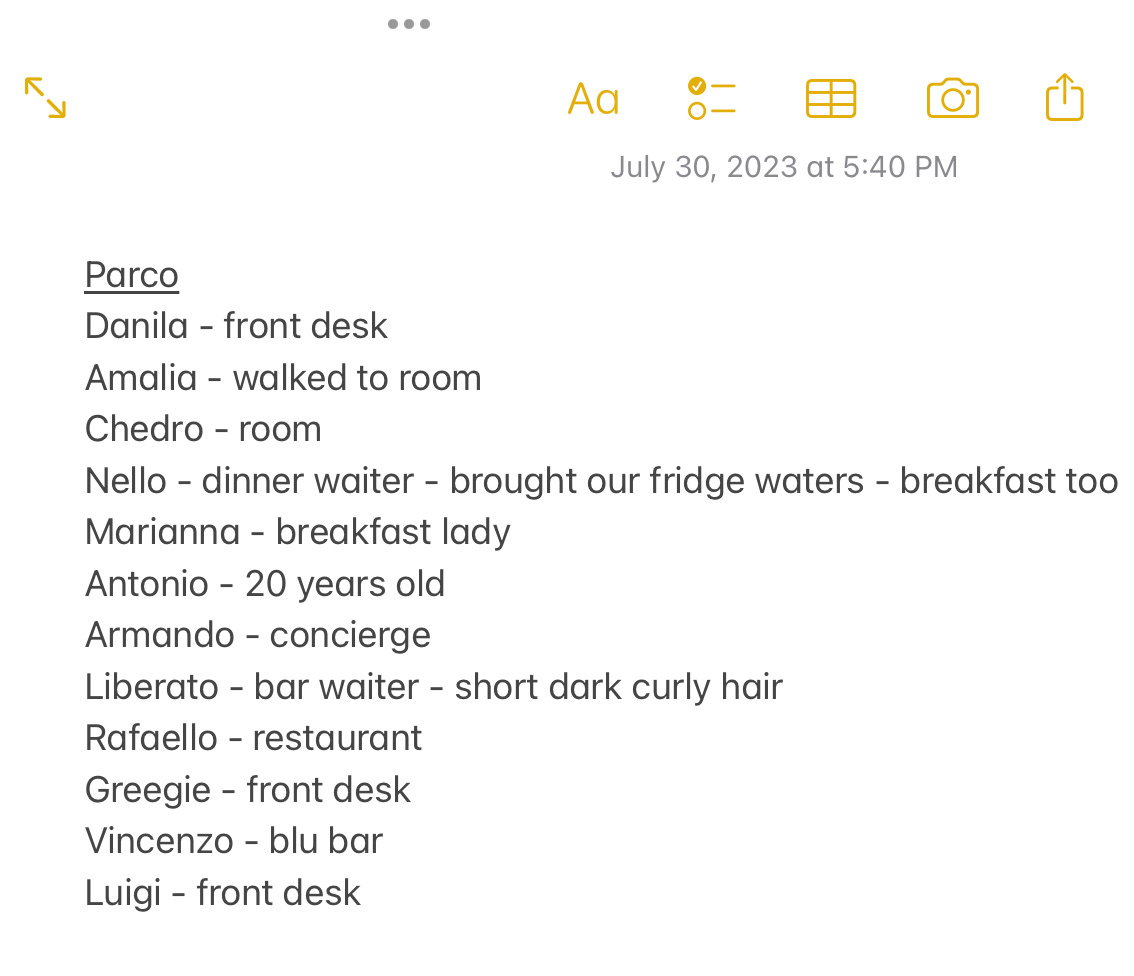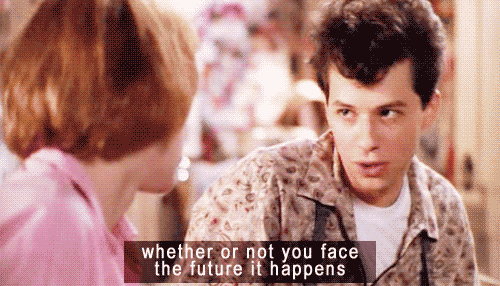Free & paid subscribers receive the exact same weekly content in their inboxes every Saturday morning. (The newsletter, vulnerable, personal, embarrassing stories, book recommendations, and whatever gifs have made me giggle.)
Considering upgrading to help myself and my editor Leona dedicate more time to The Luminist and support our current non-profit of choice: Experience Camps for grieving kids.
Earning its title of the Eternal City through two and a half thousand years of uninterrupted history, we think of Rome as a monolith.
Yet it is the embodiment of change and adaptation. The repurposing of the old to become the new. High times. Fallow times. Overrun-by-barbarians times.
Nothing says you’ve hit rock bottom like your emperor hauling ass to Byzantium (then conveniently renaming it Constantinople), abandoning you to the unwashed hordes bent on plunder. Nothing says you’ve rebuilt yourself like Michelangelo and Bernini infusing your halls and streets with beauty no other city can rival. No city on earth represents the cyclicality of life like Rome.
You rise. You fall. You rise again. Lather. Rinse. Repeat.
Rome’s story — though far grander, character-filled, and epoch-spanning — is the macro version of our individual stories. History is just better at telling it than we are at telling the stories of our own lives. Maybe because it’s hard for us to see the story that we are living inside. Maybe because we don’t want to admit that it’s a bit of a mess.
Bruce Feiler, author of Life Is in the Transitions, explains, “Primed to expect that our lives will follow a predictable path, we’re thrown when they don’t. We have linear expectations but nonlinear realities... We’re all comparing ourselves to an ideal that no longer exists and beating ourselves up for not achieving it.”
Feiler interviewed 225 Americans over three years, coming to the conclusion that the average American experiences around 36 disruptive changes in their lifetime. One every 12 to 18 months. Some of these “disruptors” are of our own choosing. Switching jobs, moving, getting married, having a baby. Many are not. And some — about three to five in every human life — are catastrophic, leveling our reality to the metaphorical ground zero. These Feiler calls “lifequakes”. They are the experiences that create the “before’s” and “after’s” we use as chapter markers in our lives. Before Covid. After Mike.
But even if the events are uncontrollable, the narrative of our story — whether it’s a tragedy, an epic, a tale of redemption, a Les Miserables, even a comedy — is entirely up to us. And I don’t know about you, but I plan on clinging to the one thing I can control, thank you very much.
It’s a choice: are we victims of circumstance, destined to drink the bitter juice of lemons for the rest of our days?
Or are we victims of circumstance who managed against the odds to turn lemons into lemonade?
Feiler describes these two ends of the lemonade-aka-personal-narrative spectrum: people who speak about disruptors as affecting their life for the worse, period – utilizing what he calls a contamination narrative. And those who describe disruptors as being hard but eventually leading to something, anything, good — utilizing a redemption narrative.
We can all guess the result of this research from a mile away. Folks that retold their past without a glimmer of silver lining were more likely to feel depressed and stuck. Folks that accepted that their past was hard, but still made a point of appreciating the daisies growing from the rubble of their lifequakes, felt more empowered and hopeful.

Feiler’s research had me borderline bouncing with glee on the drive from Rome to Sorrento. Because, similar to George Bonanno’s research on resilience, it’s so dang accessible. Any of us can start the journey from contamination to redemption at any time.
We don’t need to change the past one bit. We just have to start telling our story differently.
Adjacent to the contamination narrative, I think many of us end up in another common pitfall post-lifequake. I’m not a researcher but I spend a lot of time talking to strangers about what makes them tick. And it seems like, in American society at least, the knee-jerk reaction after a lifequake is to focus on preventing things from ever going wrong again. It’s understandable… but it doesn’t take us very far.
First, because as hard as we try to wrestle reality into submission, we just don’t have that much control over what will happen next. Second, we are still relating to the past in a way that imprisons us rather than empowers us. And while I don’t think any of us are going to manage to turn off “worry mode” for good, we can at least balance it with something constructive. We can focus on the ways we worked through the latest lifequake — with it, around it, below it, above it, however you got from there to here.
Whether it’s through journaling, bullet-pointing, voice-noting, or chatting with a dear friend, find a way to start to own your narrative (outside of your head!).
Start to examine, excavate, and elaborate the ways you’ve put the pieces of your life back together again — maybe over and over again.
Start to connect the jumbled events of your life into a constellation that once more finds a way to shine.
Start to ground in the strength you have, regardless of the mud pit you may currently find yourself in.
When we open to lifequakes — with plenty of space given to grieve and process of course— they help us reevaluate our lives.
They allow us (by forcing us) to pause, take a step back, and realign with our priorities. From there, we can carve a more purposeful, innovative, and fulfilling path forward.
Several years after Mike’s death I began telling people, “I’m going to change the conversation around death in our culture!” Wait… hold up. Sue the Hard Charger, Sue the Corporate Exec, Sue Suck-It-Up-Buttercup is going to do what?? I said it to enough astonished friends that I realized something foundational had changed within me. I just wasn’t yet sure what…
So I retraced my steps, looking for signs of what had not just saved me from the quicksand of despair, but had clearly rerouted my entire trajectory. When I looked up from my old footprints in the loamy soil, I realized I had walked past many forks in the road — places I could have turned right, trying to stay closer to “the way things used to be” but really extending my misery. Over and over again, I had instead turned left… onto a path that was entirely unknown and a little scary, but felt like possibility.
For example, I’ve always worked but as a widow I wanted my work to be more than a paycheck. Really, I needed it to be one. So I made it one. I started the annual Women’s Summit for my international company. Every year we gather from around the world to support each other, learn from each other, and connect. Work now fills part of the void that Mike left. I didn’t know I could do that. But I didn’t assume I couldn’t either. I turned left, letting myself believe that it would work out somehow.
And human connection was a molecular-level upgrade for me. “You are all alone in this world” Sue melted and morphed into “Hey, what’s your name and what’s your story” Sue. So much so that I have a long list of Italian names in my Notes app of all the people I’ve met in the last two weeks. And this fills me with almost unspeakable delight.
The redemption narrative doesn’t mean we believe that things will go back to being “good” in the same way they were before.
Rather, we let our grief drive us to try new things, discover new interests and connections and support, and build a life that is “good” in a brand new way. We trust that we are inventive enough to figure it out. We don’t give up.
When our world has been so rocked, not only does our illusion of control shatter, so do our expectations, assumptions, and self-imposed limits.
“Those facing adversity often suffer from… a feeling of being out of sync or out of touch with those around them. These attitudes, in turn, give these individuals more freedom to take risks, to experiment, to explore means of expression outside the social mainstream,” Feiler explains.
Lifequakes SUCK. I wish them on no one. But for those who have already experienced them and are trying to figure out how to write the “after” chapter, assume nothing, try anything, and trust that you’ll find something.
Right out of the gate, we handicap ourselves by assuming life is going to be plain vanilla — or maybe even rainbows and unicorns.
We are literally shocked when things go sideways. This was not what we were led to believe life is.
If life is not good, we are not happy… right? Wrong. Life is not good nor bad, it is simply unpredictable. And it’s up to us to make something of it anyway.
I’m not saying “pull yourself up by your bootstraps.” I’m saying trust that you are more resilient than you necessarily feel. And it’s okay to feel that way! No one has to move through grief and come out the other side, redeemed and victorious, today. We just have to stop telling ourselves we won’t be able to do it ever.
If we can do this, our challenges — while no less painful, disruptive, or unwelcome — feel less crippling. Part detour, part initiation, they ask us to push beyond what we thought we were capable of. They require that we step closer to the best version of ourselves. Even if we’d rather go back to “before” — yes, please — we have the option to create our own consolation prize by daring to do what we didn’t dare to do “before”.
One week from tomorrow, I walk into my next lifequake. Thankfully I can see this one coming from a mile away — and no one is getting hurt. It’s “just” an empty nest. But it’s still going to be weird. I don’t think I’m going to like it at first. But I can’t control any of that. All I can control — after feeling all the feels and letting myself process what I need to process — is my expectations for what comes next:
Eventually, somehow, someway, I’ll be okay. More than okay. I’ll make lemonade.
I no longer assume that feeling anything but bliss and happiness and fulfillment ‘til the end of my days means I’m somehow doing it wrong. I know transitions, disruptors, lifequakes are part of the package. And this mindset makes all the difference. I can lean into the discomfort and be forged by it. I can trust it won’t break me. I can give it my all. Because I’ve done it before. And even without Connor and Kendall around, I will do it again.
The goal isn’t to move backwards, to erase the pain and the change. It’s to integrate, evolve, and like Rome, rise again — a little bit less afraid to squeeze every last drop of life out of this dizzyingly swift existence.
“Chaos is not noise, it’s signal; disorder is not a mistake, it’s a design element. If we view these periods as aberrations, we risk their becoming missed opportunities. If we view them as openings, we just might open up to them. Transitions are not going away; the key to benefiting from them is to not turn away. Don’t shield your eyes when the scary parts start; that’s when the heroes are made,” as Feiler says.
In change,
If you resonated with this post and want more, check out these:
Post #5: Demystifying the griever’s mind. How stepping into the grieving mind allows us to be with others in the midst of their human experience… and our own.
Post #12: How I became a heart-seeking missile (in a good way). The epic power of our hearts to take loss and turn it into even more love.
Post #14: Things will be great again. Giving each other permission to believe in the future while honoring the pain of the present.
Post #27: Exceeding your own expectations. How my grieving teenagers became empowerment gurus.
Post #32: I think I can. I think I can. I think I can. It’s time to rewrite, and rewire, the narrative of suffering and struggle.












Sue - this might be my favorite post yet! So often we react to a lifequake and feel unable to do anything, let alone think that someday there might be a way to move forward. It took me many years to figure out how my circumstances could be transformed into something productive.
When you turn this site into a book someday, this topic should be the central theme!
Coincidentally, I’m reading this book right now, and at this point have highlighted so many passages that my highlights have become all but meaningless. And here, you’ve penned such a fiery, personal take on Bruce’s research that I wish I could highlight my entire iPhone screen, too. Your writing is brilliant, and I feel lucky to have been introduced to it today! Sending you warm wishes as you navigate your next lifequake.